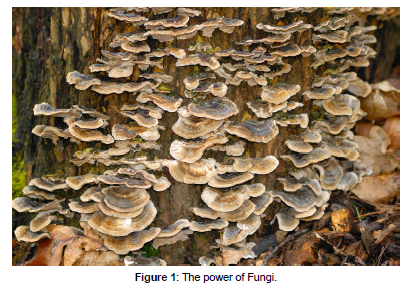Mycoremediation: Harnessing the Power of Fungi to Heal Our Environment
Received: 01-Sep-2023 / Manuscript No. . EPCC-23-113376 / Editor assigned: 04-Sep-2023 / PreQC No. . EPCC-23-113376 (PQ) / Reviewed: 18-Sep-2023 / QC No. . EPCC-23-113376 / Revised: 21-Sep-2023 / Manuscript No. EPCC-23-113376 (R) / Published Date: 28-Sep-2023 DOI: 10.4172/2573-458X.1000355
Abstract
Our planet is facing an environmental crisis, with pollution and contamination of land, water, and air becoming increasingly prevalent. As we search for sustainable solutions to combat these issues, mycoremediation has emerged as a promising and innovative method for cleaning up polluted environments. Mycoremediation is the process of using fungi to degrade, sequester, or transform various pollutants, making it a potent tool in the fight against environmental degradation. In this article, we will explore the fascinating world of mycoremediation and its potential to help heal our planet.
Keywords
Mycoremediation; Environment; Oyster mushroom
Introduction
Fungi have been an understated part of our ecosystems for millions of years. While often overlooked, they play essential roles in nutrient cycling and decomposition. Fungi are particularly adept at breaking down complex organic compounds, which makes them invaluable in mycoremediation [1, 2].
Methodology
One of the most well-known and widely used fungi in mycoremediation is the oyster mushroom (Pleurotus ostreatus). These mushrooms have a remarkable ability to break down a wide range of pollutants, including hydrocarbons, heavy metals, and even some synthetic chemicals. The secret to their success lies in their enzymes, which can efficiently degrade complex molecules into simpler, less harmful substances [3].
Types of pollutants addressed by mycoremediation
Hydrocarbon contaminants: Fungi like oyster mushrooms can break down petroleum-based compounds, such as oil and diesel, into less toxic substances. This is particularly useful in the aftermath of oil spills and industrial accidents.
Heavy metals: Some fungi, such as mycorrhizal species, can absorb and accumulate heavy metals like lead, cadmium, and arsenic, thus preventing them from leaching into the soil and groundwater.
Pesticides and herbicides: Mycoremediation has shown promise in degrading agrochemicals, reducing their impact on the environment and preventing their accumulation in the food chain.
Industrial and synthetic chemicals: Fungi are being researched for their ability to break down various synthetic chemicals, including dyes, plastics, and pharmaceuticals, which can persist in the environment for years [4, 5].
Benefits of mycoremediation
Environmental sustainability: Mycoremediation is a sustainable and environmentally friendly technique. Fungi are natural organisms that do not introduce harmful chemicals into the environment, making it a greener alternative to traditional remediation methods.
Cost-effective: Mycoremediation can be a cost-effective solution, particularly in situations where traditional clean-up methods are prohibitively expensive. Fungi are relatively easy to cultivate and can thrive on a variety of substrates, including waste materials [6].
Versatility: Mycoremediation is versatile and can be applied to different types of contaminants and environmental conditions. This adaptability is a significant advantage in addressing diverse pollution challenges.
Soil improvement: Fungi can enhance soil health by breaking down pollutants and releasing nutrients, contributing to the restoration of ecosystems and supporting plant growth [7, 8].
(Figure 1)
Challenges and Future Directions
While mycoremediation offers significant promise, it is not without its challenges. One of the main hurdles is the slow pace of fungal growth and the time required for complete remediation. Additionally, the effectiveness of mycoremediation can be influenced by factors such as temperature, moisture, and the type of pollutant.
Future research aims to address these limitations by selecting or genetically engineering fungi with enhanced pollutant degradation capabilities. Moreover, optimizing the environmental conditions for mycoremediation processes will lead to more efficient and faster cleanup efforts [9, 10].
Conclusion
Mycoremediation is an exciting and eco-friendly approach to combat environmental pollution. Fungi, with their remarkable abilities to break down and transform pollutants, offer a ray of hope in our quest for a cleaner and more sustainable planet. As we continue to explore the potential of mycoremediation, it is essential to support research and innovation in this field to unlock its full potential for healing our environment. By harnessing the power of fungi, we can take significant strides towards a cleaner and healthier world for future generations.
References
- Baun DL, Christensen TH (2004) Speciation of heavy metals in landfill leachate: a review. Waste Management and Research 22: 3-23.
- de Bok F, Stams A, Dijkema C, Boone CD (2001) Diversity of Cellulolytic Bacteria in Landfill. J Appl Bacteriol 79: 73-78.
- Canada's Action on Climate Change (2019).
- Council of the European Communities, Council Directive on Waste Landfills (1999/31/EC). Official Journal 11: 182.
- Ferronata N, Torretta V (2019) Waste Mismanagement in Developing Countries: A Review of Global Issues. Int J Environ Res & Rublic Health 2019.
- Feldman E. Asymptotic analysis of the self-heating model coal. Possibilities of forecasting fire danger (Ukrainian language).
- Gautam SP, Bundela PS, Pandey AK (2012) Diversity of Cellulolytic Microbes and the Biodegradation of Municipal Solid Waste by a Potential Strain. Int J Microbiology 1-12.
- Gendebien A (1992) Landfill gas. Comission of the EU Communities. Brussel 865.
- Gomez MA, Baldini MD, Macros M (2012) Aerobic microbial activity and solid waste biodegradation in a landfill located in a semi-arid region of Argentina. Annals of Microbiology. 62: 1-24.
- Joseph AM, Snellings R, Van den Heede Ph (2018) The Use of Municipal Solid Waste Incineration Ash in Various Building Materials: A Belgian Point of View. Materials (Basel) Jan 11: 141-145.
Indexed at, Google Scholar, Crossref
Indexed at, Google Scholar, Crossref
Citation: Husam P (2023) Mycoremediation: Harnessing the Power of Fungi to Heal Our Environment. Environ Pollut Climate Change 7: 355. DOI: 10.4172/2573-458X.1000355
Copyright: © 2023 Husam P. This is an open-access article distributed under the terms of the Creative Commons Attribution License, which permits unrestricted use, distribution, and reproduction in any medium, provided the original author and source are credited.
Share This Article
Recommended Journals
Open Access Journals
Article Tools
Article Usage
- Total views: 1105
- [From(publication date): 0-2023 - Apr 04, 2025]
- Breakdown by view type
- HTML page views: 896
- PDF downloads: 209

